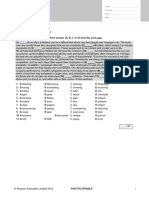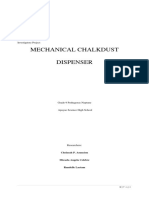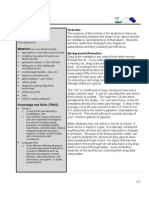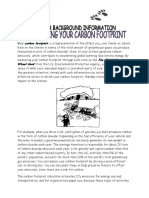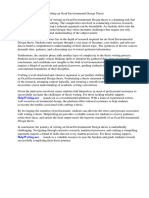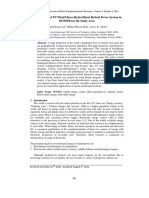Investigating Air Pollution
Investigating Air Pollution
Uploaded by
Marky Enric VasalloCopyright:
Available Formats
Investigating Air Pollution
Investigating Air Pollution
Uploaded by
Marky Enric VasalloOriginal Title
Copyright
Available Formats
Share this document
Did you find this document useful?
Is this content inappropriate?
Copyright:
Available Formats
Investigating Air Pollution
Investigating Air Pollution
Uploaded by
Marky Enric VasalloCopyright:
Available Formats
Activity: Investigating air pollution
ACTIVITY: Investigating air pollution
Activity idea
In this activity, students investigate exhaust emissions, car use and air quality.
By the end of this activity, students should be able to:
recognise some of the sources of air pollution
understand that only some pollution is visible
carry out simple scientific observations and interpret results.
Introduction/background
What you need
What to do
Introduction/background
These three activity ideas introduce students to aspects of air pollution that are often not seen,
yet are parts of everyday life. As an introduction, read the Science Ideas and Concepts article
Air quality.
What you need
Clean white socks
Vehicle(s)
Gloves
White card
Scissors
Vaseline
Tape, drawing pins
Microscope
What to do
Exhaust emissions
1. Place a white sock over the exhaust pipe of a car and run the car for 5 minutes. Stand
back while the engine is running.
2. Remove the sock – use gloves as the exhaust pipe will be hot! – and turn it inside out.
3. Discuss what you see. Soot particles are produced during the combustion of petrol and
diesel. (An average car produces approximately 2 kilograms of pollution for every 35
kilometres it travels. The UK Alliance of British Drivers website provides a short summary
of Facts About Car Exhausts.) How dirty would the sock be after longer periods of time?
4. If possible, conduct the same experiment to compare different types of car, for example
diesel versus petrol, old versus new, big versus small.
Car use
5. As a class, conduct a survey about how families of students commute in the morning and
create a visual human graph by putting students into categories depending on their
answers. For example, you could investigate:
how many students come to school by car
how far students travel by car
how many trips students do by car in a week
how students’ parents commute by car, for example, alone, car pool and so on
© Copyright. Science Learning Hub, The University of Waikato. 1
http://sciencelearn.org.nz
Activity: Investigating air pollution
which types of car are involved and how this relates to exhaust emissions.
Air quality
6. Cut out several 50 x 50 mm squares of white card and smear the surface of each lightly
with Vaseline.
7. Have students fix the squares to as many different areas you can think of, for example, by
the bus stop, inside the classroom, under trees, by a car park, on a post by traffic lights,
on a back door and so on. Leave for 24 hours. (As an alternative, you could use slightly
damp cotton wool to swab different surfaces, such as road signs, leaves on trees, window
panes and so on.)
8. The squares will now have particles stuck to them. Some will be big enough to see, but
most particles will be too small – try looking at them under a microscope.
Where do you think the particles have come from?
9. Have students devise a particle pollution indicator, from low pollution to high pollution, for
the cards based on the results you get. It is best to have about five categories.
10. Score each card on how polluted it is and use this data to draw a graph showing the level
of air pollution in the various areas.
11. Discuss the graphs. What areas were least polluted? What areas were most polluted? Are
there any links between the areas that are most polluted?
© Copyright. Science Learning Hub, The University of Waikato. 2
http://sciencelearn.org.nz
You might also like
- Iron Kingdoms Unleashed Roleplaying Game Core RulesDocument481 pagesIron Kingdoms Unleashed Roleplaying Game Core Rulesfantasynerd98% (46)
- Sean Wilentz-The Rise of American Democracy - Jefferson To Lincoln-W. W. Norton & Company (2006) PDFDocument1,098 pagesSean Wilentz-The Rise of American Democracy - Jefferson To Lincoln-W. W. Norton & Company (2006) PDFOmar Sánchez Santiago100% (6)
- DLL 1 Intro To Personal DevelopmentDocument4 pagesDLL 1 Intro To Personal Developmentanon_298904132100% (17)
- Gold C1 Adv NE UT04Document3 pagesGold C1 Adv NE UT04Silvana100% (1)
- ADDIE Model LessonDocument4 pagesADDIE Model Lessonsoonzi0482% (11)
- Elp Pushing Out Pollution Lampkins and ImpellizzeriDocument5 pagesElp Pushing Out Pollution Lampkins and Impellizzeriapi-242604347No ratings yet
- Air Pollution ExperimentDocument3 pagesAir Pollution ExperimentalifbaharunNo ratings yet
- Air Pollution ExperimentDocument2 pagesAir Pollution ExperimentAeriyy AyieNo ratings yet
- Air Pollution ExperimentDocument3 pagesAir Pollution ExperimentalifbaharunNo ratings yet
- Air Pollution ExperimentDocument3 pagesAir Pollution ExperimentaljahmeeafrahNo ratings yet
- 2nd Grade Air Lesson Plan (FINAL)Document7 pages2nd Grade Air Lesson Plan (FINAL)Indu maneshNo ratings yet
- Grade 2 - Causes of Pollution 2Document2 pagesGrade 2 - Causes of Pollution 2Chicago Dept. of TransportationNo ratings yet
- Mechanical Chalkdust Dispenser: Investigatory ProjectDocument17 pagesMechanical Chalkdust Dispenser: Investigatory ProjectBradley Gabriel100% (2)
- Standards .: Got Dirty Air?Document9 pagesStandards .: Got Dirty Air?Den Mark MasagaNo ratings yet
- What A Drag!: Target Grade Levels Time MaterialsDocument4 pagesWhat A Drag!: Target Grade Levels Time MaterialssnikhildasNo ratings yet
- Guided Discovery Lesson Plan 1Document4 pagesGuided Discovery Lesson Plan 1api-272466644No ratings yet
- Lesson TwoDocument2 pagesLesson Twoapi-305530359No ratings yet
- Grade 7 Science-Project-1T-2081Document5 pagesGrade 7 Science-Project-1T-2081samipsigdel77No ratings yet
- Lesson Plan-Otbaclean Air-A Shared Concern 2Document9 pagesLesson Plan-Otbaclean Air-A Shared Concern 2api-53533418No ratings yet
- Balloon Car ChallengeDocument8 pagesBalloon Car ChallengeZhiyong HuangNo ratings yet
- Lesson 7 in Project-Based, Life Science, Ecosystems UnitDocument4 pagesLesson 7 in Project-Based, Life Science, Ecosystems Unitapi-115850275No ratings yet
- Class O Level - Summer Vacations Task - 2024Document13 pagesClass O Level - Summer Vacations Task - 2024Sarah KhanNo ratings yet
- Science Getting About s1 Term 2 2013Document4 pagesScience Getting About s1 Term 2 2013api-184739074No ratings yet
- Unit of WorkDocument24 pagesUnit of Workapi-224046430No ratings yet
- 2013-14 Kkfs Science GuideDocument15 pages2013-14 Kkfs Science Guideapi-237447208No ratings yet
- Air Pollution ExperimentDocument3 pagesAir Pollution Experimentwmaughn3989No ratings yet
- Air Strips Lesson Plan: Student ObjectivesDocument4 pagesAir Strips Lesson Plan: Student ObjectivesGASPgroupNo ratings yet
- Nano Waterproofing: Provided by TryengineeringDocument12 pagesNano Waterproofing: Provided by Tryengineeringdelmarciogomes6739No ratings yet
- Science Lesson 1Document8 pagesScience Lesson 1api-400249453No ratings yet
- RESEARCHDocument1 pageRESEARCHLucy AlmonteNo ratings yet
- Unit 4 Grades 10-12 Activity 4.2 CalculatingYourCarbonFootprintDocument9 pagesUnit 4 Grades 10-12 Activity 4.2 CalculatingYourCarbonFootprintJuventie PrimastutiNo ratings yet
- Water: A Global Experiment With HydrogelsDocument16 pagesWater: A Global Experiment With HydrogelsHải Yến TrầnNo ratings yet
- 5e Lesson Plan Erosion WstokleyDocument4 pages5e Lesson Plan Erosion Wstokleyapi-4805117500% (1)
- Investogatory+Project+Format+ +chapters+1 3Document9 pagesInvestogatory+Project+Format+ +chapters+1 3Aaron BondNo ratings yet
- Problem Based Learning, STEM ExperienceDocument11 pagesProblem Based Learning, STEM ExperienceSiti MonalisaNo ratings yet
- Enviro Science Design BriefDocument6 pagesEnviro Science Design Briefapi-483325574No ratings yet
- Balloon Car TeacherDocument3 pagesBalloon Car Teachermayamaheshreddy123No ratings yet
- Ecology ProblemsDocument4 pagesEcology Problemssaidakambarova155No ratings yet
- Scientificinq 1Document5 pagesScientificinq 1api-239373469No ratings yet
- Windtunnels PDFDocument11 pagesWindtunnels PDFmgskumarNo ratings yet
- Env 8Document44 pagesEnv 8Kamal Kant GuptaNo ratings yet
- Lesson 3 Activities Systematic Approach To TeachingDocument3 pagesLesson 3 Activities Systematic Approach To TeachingAlvin CabanelaNo ratings yet
- Task 2 - ContDocument8 pagesTask 2 - ContEsther MinNo ratings yet
- Calculating Your Carbon FootprintDocument13 pagesCalculating Your Carbon Footprintshamroz khanNo ratings yet
- Isrc Science Fair: Tel: +92-334-7079270 WebsiteDocument10 pagesIsrc Science Fair: Tel: +92-334-7079270 Websitehamza saleemNo ratings yet
- ApproachesDocument1 pageApproachesRomulo Benigno BatucolNo ratings yet
- Sons 2022 Guiding Theme B Sustainable Development Goals in Education 0Document21 pagesSons 2022 Guiding Theme B Sustainable Development Goals in Education 0AsasNo ratings yet
- 5 e Lesson ExamplesDocument10 pages5 e Lesson ExamplesRachel Mañosca-FloresNo ratings yet
- Science Meet KutuhalDocument4 pagesScience Meet KutuhalnitinNo ratings yet
- Development of Vehicles Gas Emission Wireless Monitoring SystemDocument5 pagesDevelopment of Vehicles Gas Emission Wireless Monitoring SystemDennis SinnedNo ratings yet
- CAMBIO Climatio Aiesec - Proyecto PeruDocument7 pagesCAMBIO Climatio Aiesec - Proyecto PeruloquilloNo ratings yet
- k2 InthemixDocument7 pagesk2 Inthemixapi-281106614No ratings yet
- University of Cambridge International Examinations General Certificate of Education Advanced Subsidiary Level and Advanced LevelDocument4 pagesUniversity of Cambridge International Examinations General Certificate of Education Advanced Subsidiary Level and Advanced LevelJazzNo ratings yet
- Ocad Environmental Design ThesisDocument7 pagesOcad Environmental Design Thesisbethwoodwardsiouxfalls100% (2)
- What I Need To KnowDocument5 pagesWhat I Need To KnowEr WinNo ratings yet
- 005 001 000 017 Filtration InvestegationDocument12 pages005 001 000 017 Filtration InvestegationBalian1908No ratings yet
- L 1: G I S O:: Esson Arbage and The Mpact of Cale VerviewDocument10 pagesL 1: G I S O:: Esson Arbage and The Mpact of Cale VerviewUrban EcoLab CurriculumNo ratings yet
- S3 BiologyDocument36 pagesS3 Biologyatimlucy98No ratings yet
- Air Pollution Lesson PlanDocument11 pagesAir Pollution Lesson PlanThe Service Dog LifeNo ratings yet
- Worksheet A. Match The Questions To The Answers About Climate ChangeDocument6 pagesWorksheet A. Match The Questions To The Answers About Climate ChangeByamba Erdene Nyam OsorNo ratings yet
- How to Empower Children in the World: Earth Leaders for Environmental MonitoringFrom EverandHow to Empower Children in the World: Earth Leaders for Environmental MonitoringNo ratings yet
- Optimization of PV Wind Micro-Hydro Diesel Hybrid Power System in HOMER For The Study AreaDocument19 pagesOptimization of PV Wind Micro-Hydro Diesel Hybrid Power System in HOMER For The Study AreaRodrigoNo ratings yet
- NAB RobDocument6 pagesNAB Robfriend_foru2121No ratings yet
- Development of A Constant Switching Frequency Deadbeat Predictive Control Technique For Field-Oriented Synchronous Permanent-Magnet Motor DriveDocument9 pagesDevelopment of A Constant Switching Frequency Deadbeat Predictive Control Technique For Field-Oriented Synchronous Permanent-Magnet Motor DriveYusuf BelloNo ratings yet
- Formation of Contracts - CISGDocument3 pagesFormation of Contracts - CISGSimina DuracNo ratings yet
- Reviewer in RFBT Special LAWS Reviewer in RFBT Special LAWSDocument15 pagesReviewer in RFBT Special LAWS Reviewer in RFBT Special LAWSZyrelle DelgadoNo ratings yet
- Five-Minute Tests Answer Key: Pages 8-9 Test BDocument5 pagesFive-Minute Tests Answer Key: Pages 8-9 Test BTillmannNo ratings yet
- Sample Project ReportDocument52 pagesSample Project ReportUma maheswara Reddy KotaNo ratings yet
- Hello Nice Meeting You Can We Be Friend (13-29)Document16 pagesHello Nice Meeting You Can We Be Friend (13-29)firstsonokorieNo ratings yet
- Mph102t DdsDocument7 pagesMph102t DdsAakash PrajapatiNo ratings yet
- ContourunitDocument3 pagesContourunitapi-263381268No ratings yet
- Quiz Final 2024 Project - Docx Al ChunnyDocument35 pagesQuiz Final 2024 Project - Docx Al ChunnyroshanscariamathewNo ratings yet
- Kark Rashi Baby Boy Names With MeaningsDocument7 pagesKark Rashi Baby Boy Names With Meaningspoojamistry_123No ratings yet
- Instant Ebooks Textbook Sharing With The Gods Aparchai and Dekatai in Ancient Greece Theodora Suk Fong Jim Download All ChaptersDocument84 pagesInstant Ebooks Textbook Sharing With The Gods Aparchai and Dekatai in Ancient Greece Theodora Suk Fong Jim Download All Chaptersveysohyabw100% (6)
- In Lý Thuyết Tiếng Tổng Hợp Trắc Nghiệm Phần 1 ^0 3Document25 pagesIn Lý Thuyết Tiếng Tổng Hợp Trắc Nghiệm Phần 1 ^0 3ThuyNguyenNo ratings yet
- In His Eyes - My GangsterDocument229 pagesIn His Eyes - My Gangsternhetekwanokubongaj100% (1)
- Example of Literature Review in Lab ReportDocument7 pagesExample of Literature Review in Lab Reportbujuj1tunag2100% (1)
- Cinnamon and its derivatives as potential ingredient in functional food A reviewDocument28 pagesCinnamon and its derivatives as potential ingredient in functional food A reviewYusuf AndrianaNo ratings yet
- A Practice of Buddha Shakyamuni by Mipham RinpocheDocument6 pagesA Practice of Buddha Shakyamuni by Mipham RinpocheTanaduk100% (1)
- Control The Money, Control The MediaDocument18 pagesControl The Money, Control The Mediaali sultanNo ratings yet
- SK Realty v. UyDocument3 pagesSK Realty v. UySienna NacarioNo ratings yet
- Text For Questions No. 1 and 2. Subject: Dinda Sekar Merah, Support General Manager ImportantDocument2 pagesText For Questions No. 1 and 2. Subject: Dinda Sekar Merah, Support General Manager ImportantNur Aqmalul AuliaNo ratings yet
- POB Lab ManualDocument11 pagesPOB Lab ManualWEY LOON LIMNo ratings yet
- Lecture 2 - BiopsychDocument54 pagesLecture 2 - BiopsychAbraham KangNo ratings yet
- Fiche de Paie Ahmed BoudinarDocument1 pageFiche de Paie Ahmed Boudinarjorta4400No ratings yet
- Titp SSW 03 01 2023Document6 pagesTitp SSW 03 01 2023Coleen Macias Meneses0% (1)
- Elementary/Pre-Intermediate Placement Test A1.2/A2.1/A2.2 GrammarDocument11 pagesElementary/Pre-Intermediate Placement Test A1.2/A2.1/A2.2 GrammarMica MucioniuNo ratings yet



